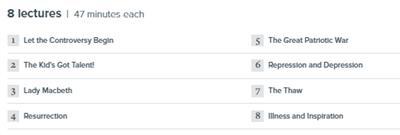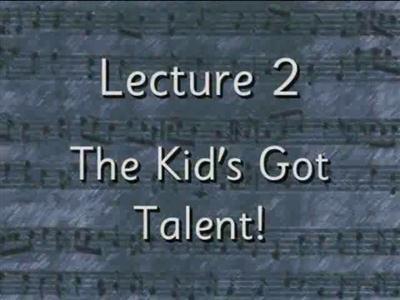Discover the extraordinary life, times, and art of Dmitri Shostakovich (1906-1975), great musical master and flawed but faithful witness to the survival of the human spirit under totalitarianism. He is without a doubt one of the absolutely central composers of the 20th century. His symphonies and string quartets are mainstays of the repertoire.
Great Masters: Shostakovich-His Life and Music
8xWEBRip | English | AVI + PDF Guide | 640 x 480 | DX50 ~393 kbps | 29.970 fps
MP3 | 128 kbps | 48.0 KHz | 2 channels | 06:15:25 | 1.41 GB
Genre: eLearning Video / Biography, Music
But Shostakovich is also a figure whose story raises challenging and exciting issues that go far beyond music: They touch on questions of conscience, of the moral role of the artist, of the plight of humanity in the face of total war and mass oppression, and of the inner life of history's bloodiest century.
A Soviet Impression
The Bolshevik Revolution took place when Dmitri Shostakovich was a boy of 11. His life and career from then on coincided with, and in a sense mirrored, the rise, tortured life, and eventual failure of the Soviet communist regime.
The premise of Professor Robert Greenberg's approach to this giant among 20th-century composers is that nothing he said publicly about his music ("for official Soviet consumption") should be taken at face value. He lived the great bulk of his career under Stalin, and he knew what that meant. He had seen friends taken away in the purges, never to return.
The crucial aspect on Shostakovich's career, argues Professor Greenberg, is defined by his posthumous book of reminiscences, Testimony: The Memoirs of Dmitri Shostakovich, a volume based on a series of extraordinarily frank private interviews that the composer gave to a young Soviet musicologist named Solomon Volkov.
In them, Shostakovich makes clear that he was no hero or martyr-as a friend said, "He did not want to rot in a prison or a graveyard"-but also shows that at the same time he was never willing to become a docile instrument of the Soviet regime.
Shostakovich speaks through his music, which bears messages from a buried life of his experiences during the terror of Stalin, the Nazi destruction of his country, postwar reconstruction, and the arms race. To decode these messages, you study a mix of biographical information intertwined with numerous musical excerpts from the composer's work.
You learn to hear how, in work after work, often composed under circumstances of crushing difficulty and anxiety, Shostakovich used a brilliant arsenal of ironic juxtapositions (a piping piccolo theme in a symphony supposed to glorify Stalin, for instance), musical quotes from such un-Soviet sources as American jazz or Jewish klezmer tunes, and other techniques to assert the integrity of his art in the face of totalitarian oppression, and to pay, as he said, "homage to the dead."
Professor Greenberg provides careful, gripping accounts of the political circumstances amid which Shostakovich composed his masterworks-meaning above all his 15 symphonies and 15 string quartets.
Shostakovich: Portrait of the Artist as Witness and Survivor
The flood of declassified material that has come pouring out of old Soviet archives since 1991 is a rich resource for these lectures. The tale this material tells is harrowing, but it is one we cannot look away from, notes Professor Greenberg.
Certainly, he says, we will never understand Shostakovich unless and until we come to grips with it, for only by knowing this awful history can we hope to grasp anything even approaching "the full and true meaning of the art that this frail, fearful, and outwardly timid but inwardly resolute genius has bequeathed to us, his fortunate posterity.
"Unlike the other musical biographies that I have created for The Teaching Company, this one-Shostakovich's-will have more than its share of controversy," says Professor Greenberg.
"There are two reasons for this. The first is simple enough: Having died fairly recently, and having composed major works almost to the end of his life, Shostakovich is a very 'fresh' figure. We are still coming to terms with his enormously influential compositional output-particularly his symphonies and string quartets, works which are so central to the contemporary repertoire.
"The second reason for the controversy is far more complicated: Shostakovich was a Soviet artist, and the Soviet State used his music as a tool. Art and politics make strange and problematic bedfellows. But they are a coupling that we cannot possibly avoid if we are to talk about Dmitri Shostakovich and his music. These lectures, then, tell the story of a man and his art, a place and a political system, all of them truly indivisible from one another."
Shostakovich knew Stalin personally and was singled out for criticism by him. Shostakovich was not just the single most important composer of string quartets and symphonies from the 1920s to the 1970s, he was a witness to the rise and failure of Soviet Communism, perhaps the defining event of the 20th century.
Biography Presented in Detail
Among what you learn about Shostakovich's life is:
After the condemnation of his music by Stalin in 1936, Shostakovich never left home without soap and a toothbrush, so convinced was he that he would be arrested.
He included a special set of notes representing a "musical signature" in many of his works.
The Quintet for Piano and Strings in G Minor of 1940 comments on the official Soviet preference for upbeat, "accessible" music by sandwiching a movement that quotes the bumptious theme associated with Russian circus clowns between movements that brilliantly pay tribute to J. S. Bach.
Shostakovich loved Jewish music-especially klezmer because of the way it combines joy with despair. Defying Soviet anti-Semitism, he "quoted" Jewish music in works such as 1944's Piano Trio in E Minor, wrote a song cycle called From Jewish Poetry (1948), and famously memorialized the plight of persecuted and murdered Jews in his Babi Yar Symphony of 1962.
The brutal and vicious second-movement scherzo of the magnificent 10th Symphony was written that way because it was intended as a musical portrait of the recently deceased Josef Stalin.
An Artist for Humanity
When Dmitri Shostakovich died in Moscow on December 9, 1975, he was "hailed as a 'hero of the people,' " says Professor Greenberg. "But we know him as a survivor, a witness, and an artist who spoke for all of humanity."
Works you'll hear in the lectures are excerpted from:
Symphony no. 3 in E-flat Major, op. 20 (1929)
Lady Macbeth of Mtsensk, op. 29, (1930-32)
Symphony no. 5 in D Minor, op. 47 (1937)
String Quartet no. 1 in C Major, op. 49 (1938)
Quintet for Piano and Strings in G Minor, op. 57 (1940)
Symphony no. 7 in C Major, op. 60, Leningrad (1941)
Piano Trio in E Minor, op. 67 (1944)
String Quartet no. 3 in F Major, op. 73 (1946)
String Quartet no. 5 in B-flat Major, op. 92 (1952)
Symphony no. 10 in E Minor, op. 93 (1953)
String Quartet no. 7 in F-sharp Minor, op. 108 (1960)
Symphony no. 13 in B-flat Minor, op. 113, Babi Yar (1962)
String Quartet no. 10 in A-flat Major, op. 118 (1964)
String Quartet no. 15 in E-flat Minor, op. 144 (1974)
Download link:
uploadgig_com:
[Misafirler Kayıt Olmadan Link Göremezler Lütfen Kayıt İçin Tıklayın ! ]
uploaded_net:
[Misafirler Kayıt Olmadan Link Göremezler Lütfen Kayıt İçin Tıklayın ! ]Links are Interchangeable - No Password - Single Extraction
1 sonuçtan 1 ile 1 arası
-
19.05.2017 #1Üye



- Üyelik tarihi
- 20.08.2016
- Mesajlar
- 144.947
- Konular
- 0
- Bölümü
- Bilgisayar
- Cinsiyet
- Kadın
- Tecrübe Puanı
- 153
Great Masters Shostakovich-His Life and Music.
Konu Bilgileri
Users Browsing this Thread
Şu an 1 kullanıcı var. (0 üye ve 1 konuk)



 LinkBack URL
LinkBack URL About LinkBacks
About LinkBacks








 Alıntı
Alıntı
Konuyu Favori Sayfanıza Ekleyin